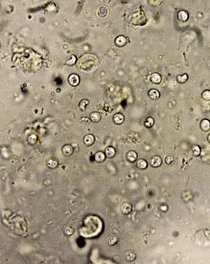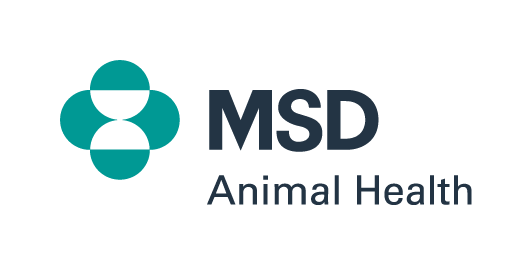
Calf Scour
A page about scour in calves including the causes (Rotavirus, Coronavirus, E. coli), the clinical signs and how to reduce the risk of it.

Information
Diarrhoea is an increase in the water content, frequency, and volume of faeces. (Normal faeces is 25% solid material, while in diarrhoea more than 80% of total faeces is water). Neonatal calf diarrhoea (NCD) is the most important part of the veterinary costs for calves under one month old(Estimated previously up to 29% of all treatment costs). In older calves, diarrhoea is the second most important reason for drug & vaccine spending (Estimated previously at 16% of expenditure) and is second only to respiratory disease. It is commonly the single biggest cause of mortality in cattle <2 months old.

Aetiology
The aetiology (cause) of neonatal calf diarrhoea is multifactorial. It may be non-infectious (mainly due to nutrition) or infectious.
Non-infectious scour: Mistakes in the management of milk replacer, in the quantity or quality of milk replacer, and in calf management are the main causes of non-infectious diarrhoea. These include:
Irregular feeding
Milk fed while too cold
Milk replacer not properly dissolved
Drinking from an open bucket without training
Stressors.
In addition, different management failures leading to ill-thrift will ultimately cause diarrhoea. These include depriving diarrhoeic calves of milk for too long and poor weaning practices, where the intestine is not allowed to develop sufficiently and become accustomed to roughage.
Infectious scour: This can be caused by bacteria, viruses and parasites (protozoa)
Rotavirus and Cryptosporidium the most frequently isolated agents from scour in calves. These pathogens (disease causing agents) can be associated with a high mortality rate.
Other pathogens that may also be responsible for disease include:
Enteric viruses:- Coronavirus, BVD
Other bacteria e.g. Enterotoxigenic E. coli, Salmonella, Clostridium perfringens
Other parasites e.g. Coccidia, Giardia
Epidemiology
| Infectious agent | Age affected |
| Bacteria | |
| E. coli (ETEC) | 1-5 days |
| Salmonella spp. | 4-28 days and older |
| Clos. perfringens Types A, B & C | 1-15 days and older |
| Viruses | |
| Rotavirus | 5-14 days |
| Coronavirus | 5-30 days |
| Protozoa | |
| Cryptosporidium parvum | 5-20 days |
| Eimeria spp. (Coccidiosis) | >3 weeks |
| Giardia spp. | > 15 days |
Various factors influence the incidence of infectious diarrhoea including:
a) ENVIRONMENTAL FACTORS
– Herd characteristics and management practices – Diarrhoea incidence increases in the following circumstances – Larger herd size, suckling colostrum directly from the dam and leaving the calf with the dam more than 1 hour, mixed age groups comprising peripartum cows, sick cows or recently weaned calves, housing of calves in groups, the use of poorly prepared milk replacers or where feeding is irregular
– Level of environmental hygiene – Poor hygienic practices and overcrowding increase the risk of infection and diarrhoea
– Weather conditions – In the case of beef cattle, confining calving cows during inclement weather is a common practice, and overcrowding may be followed by an outbreak of calf diarrhoea
b) CALF FACTORS
– Calf immune status – The specific immunity of the newborn calf is dependent on colostrum intake. This is in turn influenced by the quality of the colostrum produced by the dam, the quantity taken in by the calf and the timing after calving during which that intake occurs. The lack of this passive transfer of immunity is the MAIN RISK FACTOR for neonatal diarrhoea
– Age – Calf age determines the onset of the different pathogens involved in neonatal diarrhoea. Further detail on this is provided under each of the pathogens concerned.
c) PATHOGEN FACTORS
Mixed infections with more than one agent e.g. Rotavirus plus Cryptosporidium are more common than single infections, lead to more severe diarrhoea than single component infections and tend to prolong the normal age-related expectation for given scour agents. Certain agents affect calves at relatively predictable ages ( See table above)

Clinical Signs
When we are faced with a calf with diarrhoea, we should evaluate the score of diarrhoea, dehydration, and the presence of acidosis and/or septicaemia in order to establish a correct diagnosis, prognosis and treatment.
Diarrhoea is scored as normal, loose, pasty, watery or containing blood. Score determines how fast a calf is likely to deteriorate.
To evaluate dehydration we use different parameters: How sunken the eye is in its socket
Skin tenting: to evaluate it, pinch a fold of skin and count the seconds that it takes to flatten
Gum color and moisture: normal gums should be pink and damp
Attitude during milk feeding: suckling reflex should be strong in healthy calves.
Temperature of extremities (ears)
Acidosis is not easy to evaluate in a clinical situation as it involves signficant expensive tests that are not highly reliable. In practice, acidosis is evaluated through three signs: Ability to stand, depression and strength of suck reflex (decreased or absent).
Septicaemia is not only a frequent diarrhoeal complication, but it is also the main differential diagnosis for neonatal diarrhoea. Early signs indicative of septicaemia are: inability to stand, depression, anorexia, absent or decreased suckling reflex, fever or hypothermia (low body temperature), reddening of the eyeball due to haemorrhage or congestion.

Diagnosis
Various samples must be submitted to the laboratory for analysis to confirm cause:
a) Scour samples: Aim to submit at least 5 samples from different calves to ensure that if it is a mixed infection, all causal agents will be identified. A request must be made to evaluate the sample for all bacteria, viruses and protozoa.
b) Blood samples: If a clotted sample is taken from a calf between 2-5 days old, it may be submitted to the lab for zinc sulphate turbidity testing. A result of > 20 indicates passive transfer of immunity is probably adequate
c) Colostrum samples: Samples of colostrum from freshly calved cows which have not yet been suckled may be submitted to a specialist laboratory for analysis for levels of specific antibodies against rotavirus and coronavirus.
d) Ear notch testing for BVD PCR may also be considered.
Control
Control of neonatal calf diarrhoea is based on four equally important aspects:
- Hygiene – the calving box and early calf rearing accomodation must be cleaned and disinfected between calves. If a calf becomes infected, it multiplies many of the scour agents so that if another calf is subsequently housed in the same accomodation, the risk increases dramatically as the dose the next calf is exposed to is much higher
- Management – Ensure all calves receive at least 10% of bodyweight as colostrum within the first 12 hours after birth, with 3 litres given within 2 hours of birth at first feed. Subsequently calves should receive either post-colostral milk for up to 3 weeks or colostrum mixed in with normal milk to ensure an ongoing supply of antibody to protect the calves against particularly viral infection. Avoid mixing young calves with older animals.
- Biosecurity – Maintaining biosecurity involves avoiding introduction of infected animals into the herd and/or implementing stict isolation / quarantine of introductions until proven negative, and restricting access of calves to external sources of infection e.g. bringing calves to the mart and mixing them back in with home reared calves if unsold.
- Vaccination – The use of vaccine in cows must be considered if problems associated with E. coli, rotavirus or coronavirus are identified. Bovilis Rotavec Corona is a vaccine produced by MSD Animal Health that is administered 3-12 weeks before calving to raise antibodies to these three scour agents.
- Cryptosporidiosis may be controlled by the use of a product containing halofuginone administered orally daily for up to one week after birth. Consult your vet for further advice in this area. Bovilis Cryptium is a subunit vaccine against Cryptosporidium parvum whereby, in the first year of use, a primary course of two doses must be given spaced 4 weeks apart with the second dose administered between 12 and 3 weeks prior to calving. For each subsequent pregnancy a single dose is administered between 12 and 3 weeks prior to calving.
- These vaccines induce colostral antibodies which are protective against the agents contained in the vaccine, when the calf is administered sufficient colostrum after birth and for the subsequent number of days indicated on each of the product leaflets. They are available under prescription from your veterinary practitioner from whom advice should be sought.
- Coccidiosis may be controlled by use of products that contain diclazuril or toltrazuril. MSD Animal Health market a product containing diclazuril, which favours the development of immunity, and lead to better weight gains, in older calves, in a study where it was compared to toltrazuril. Consult your vet for further details.
- Giardiasis may be controlled by use of products that contain fenbendazole, though none are licensed for this specific indication. Consult your vet for details.
